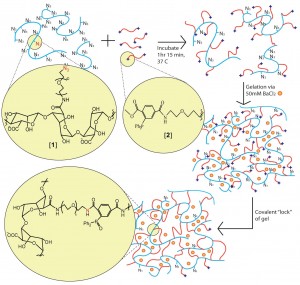Chemoselective Polymers
 The development of novel, functionalized polymers with complimentary reactive groups for forming covalent linkages would serve as platforms for providing more tools to engineering tissues, as well as serving for building nano-scale layers on a cell surface. The building of multiple nanoscale layers on a cell surface using covalent methods is challenging in that there are significant limitations in the number of chemoselective reactions that can occur in a biological environment. Chemoselectivity is critical in the development of stable layers with characterizable features. In addition, chemoselectivity is needed to permit reactivity within fully supplemented media solutions, a necessary feature when coating cells with high metabolic rates. Chemo-selectivity and cell compatibility of bondage between polymer layers is of critical importance for cellular systems. In our laboratory, we have focused on the fabrication of novel polymers capable of forming site-specific, covalent linkages without the need for catalysts and resulting in non-toxic byproducts. We have capitalized on recent developments by Bertozzi et al, where the classical Staudinger Reaction and Click Chemistry ligation schemes were adapted to create stable chemoselective covalent ligation in a biological environment. Our publications have highlighted the novelty of linking these complimentary Staudinger ligation groups onto highly biocompatible polymers such as poly(ethylene glycol) and alginate. In these studies, we have illustrated the enhanced stability of alginate-based hydrogels, through the use of Staudinger ligation based polymers. We are continually developing new polymers to assist us in forming stable, cell-compatible, covalent linkages in the presence of cells.
The development of novel, functionalized polymers with complimentary reactive groups for forming covalent linkages would serve as platforms for providing more tools to engineering tissues, as well as serving for building nano-scale layers on a cell surface. The building of multiple nanoscale layers on a cell surface using covalent methods is challenging in that there are significant limitations in the number of chemoselective reactions that can occur in a biological environment. Chemoselectivity is critical in the development of stable layers with characterizable features. In addition, chemoselectivity is needed to permit reactivity within fully supplemented media solutions, a necessary feature when coating cells with high metabolic rates. Chemo-selectivity and cell compatibility of bondage between polymer layers is of critical importance for cellular systems. In our laboratory, we have focused on the fabrication of novel polymers capable of forming site-specific, covalent linkages without the need for catalysts and resulting in non-toxic byproducts. We have capitalized on recent developments by Bertozzi et al, where the classical Staudinger Reaction and Click Chemistry ligation schemes were adapted to create stable chemoselective covalent ligation in a biological environment. Our publications have highlighted the novelty of linking these complimentary Staudinger ligation groups onto highly biocompatible polymers such as poly(ethylene glycol) and alginate. In these studies, we have illustrated the enhanced stability of alginate-based hydrogels, through the use of Staudinger ligation based polymers. We are continually developing new polymers to assist us in forming stable, cell-compatible, covalent linkages in the presence of cells.
These efforts are currently being supported by an NIH R01

